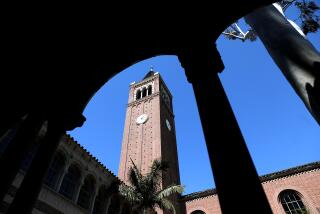PACIFIC RIM ARTS : U.S.-China Arts Exchange: Between the Lines
- Share via
At the start of the Memorial Day weekend, baritone John Raitt sang several bars of “Oh What a Beautiful Morning” from “Oklahoma!” to a delegation of visiting Chinese cultural officials. On this Saturday morning in Pasadena, against a backdrop of white outdoor furniture and lush green lawn, a beautiful morning is all it seemed to be--on the surface.
Lu Zhengwu, foreign affairs chief for the Bureau of Arts Education in Beijing, who is responsible for international cultural exchanges and speaks English, said he was “most pleased to meet our American friends in the sunshine, and on such a wonderful day.”
Yet at the American Center for Music Theater Training reception at Huntington Cottages, talk of the massive pro-democracy student demonstrations in Beijing also blossomed--but only privately in little clusters.
Before the main event indoors of musical performances primarily by high school students with accompanying commentaries by center director Paul G. Gleason, Chen Shuyu, consul for cultural affairs of the Consulate General of the People’s Republic of China in Los Angeles, appeared to downplay what is happening in China.
Talking to Gardena High School arts teacher Phila McDaniel and reporters, Chen said that “certainly the students wanted to speed (economic and political reform) up,” but indicated the government does as well. “We have advocated political reform,” Chen said matter-of-factly.
Although the Western press was reporting the re-emergence of hard-line Prime Minister Li Peng, Chen denied that “there are any power struggles.” He added that Zhao Ziyang, the more moderate leader who is favored by the students, is “still head of the Communist Party.”
As for repercussions against the students, Chen shook his head and smiled: “I don’t think so,” he said.
During a brief “arts dialogue” conducted by Gleason, who sought to restrict questioning to cultural matters, Lu said that in China there were nine academies each in music and the visual arts, two for theater and one for dance. “What I want to stress very much,” he said, “we cater to our traditional arts in China. At the same time, we would like to learn about the fine arts. In Chinese traditional opera, we have 50 schools of Beijing Opera on the secondary level and one on the college level. I’m ready for more.”
Lu declined comment when asked about the demonstrations, pleading a busy schedule. There was also “no time to watch TV,” he said.
At his side, delegation leader Fang Qian, director of the Bureau of Arts Education, who also does not speak English, broke into a broad smile when the question about demonstrations was interpreted to him, and said a direct “Sorry.”
But during an informal chat, Xu Shijia, deputy director of the Central Conservatory in Beijing, which has about 500 students ranging in age from 18 to 28, said through a consulate interpreter that about 30 of his students were involved in the demonstrations--at least before he left China. “That doesn’t mean more do not agree with them,” he added.
“We don’t know much about what’s happening because we have been away for a long time,” Xu noted.
Du Jian, deputy director/professor at the Central Academy of Visual Arts in Beijing, which has about 400 college-age students, said through the same interpreter that about 100 of his students are involved.
Du asserted that while he might agree with some of their demands, “their methods could be discussed. . . . We hope all the demonstrations could go through legal procedures (as) in America.” He did not elaborate.
The music training center, originally founded by Civic Light Opera, had been selected as one of the dozen sites around the country by the Kennedy Center for the Performing Arts and the State Department to show the delegation of four how “pre-professional” students of music are trained. After a trip to San Francisco, the men, who have been in the United States since May 10, return to Beijing on Tuesday.
Although the music training center concentrates on professional-level students--”you cannot be an Olympic singer at 13 or 18 but you can be at 35,” said Gleason--his organization’s music training programs also include a summer workshop and educational programs in four county school districts for high school students.
Some students who have been involved in center programs performed Saturday. Despite the fact that the music was clearly enjoyed by the Chinese whether they understood English or not, there was also a certain irony in this portion of the program.
Ray Saar, 32, a former center student who currently plays the role of French Revolution student leader Enjolras in “Les Miserables” at the Shubert Theatre, sang briefly of student leader Lemarc whose death would become a rallying cry.
While the program continued, Saar whispered that in “Les Miz,” students also carry red banners.
“Watching on TV, when you see these people, all the students out there, their lives are on the line,” Saar said, “and they’re out there standing up strong for what they believe, it’s very exciting to see that. So if you can transfer any of that kind of excitement onto the stage and give people that feeling of danger . . . “
More to Read
The biggest entertainment stories
Get our big stories about Hollywood, film, television, music, arts, culture and more right in your inbox as soon as they publish.
You may occasionally receive promotional content from the Los Angeles Times.










